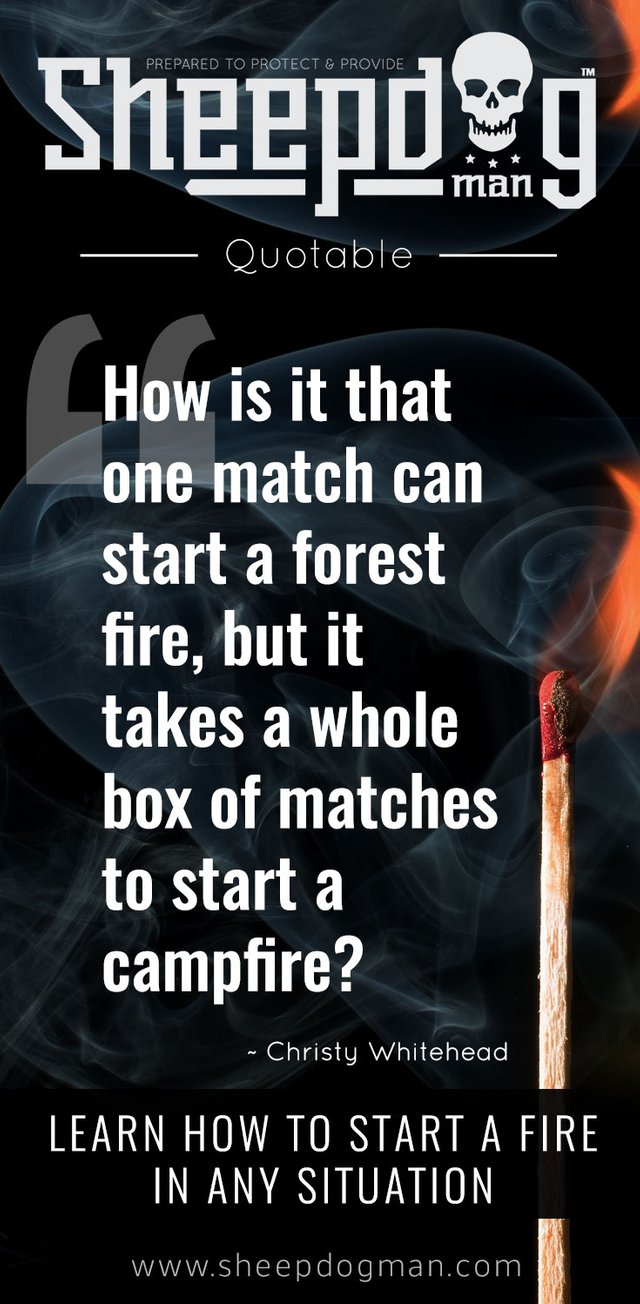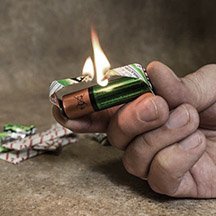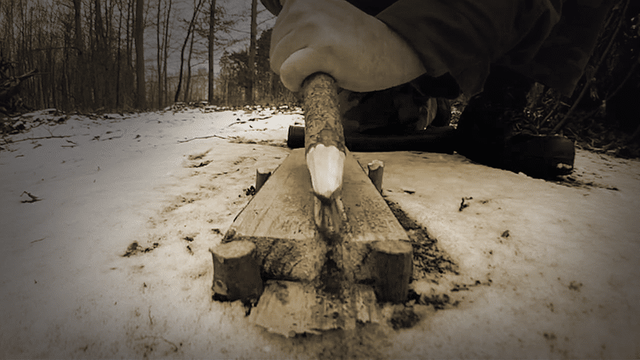
Starting a Fire: a Magical Experience
Let's face it. We're pyromaniacs at heart. I mean who doesn't enjoy starting a fire. Right? I'll never forget how happy I was when my dad first let me take a shot at starting a fire. I was beyond excited!
Likewise, I'll never forget the glorious experience of starting a fire after a long day of hunting in the frozen Idaho wilderness. Or waking to a fresh coat of snow on the ground and sub-zero temperatures, fiddling around with fingers that felt twice their normal size and inflexible as stone, to finally, after some struggle, get the fire to take and basking in its wonderful heat. Feeling the warmth of the fire on my frozen fingers was magical.
However, sometimes starting a fire can be difficult.
Maybe you've experienced this. It can be hard to start a fire when it's cold or damp, or you don't have a fire starter on hand. Unfortunately, it is at times like these that one needs the warmth of a fire the most. I love how Christy Whitehead observed the effect of Murphy's Law when she said,
How is it that one match can start a forest fire, but it takes a whole box of matches to start a campfire? ~ Christy Whitehead

We're here to make sure you have success by showing you how to start a fire in any situation.
Now, it goes without saying that fire can save your life. It can prevent hypothermia and frostbite, it can keep predators at bay, and it can cook food and purify water.
Fire is magical, as long as you can put it out.
Man is the only creature that dares to light a fire and live with it. The reason? Because he alone has learned to put it out. ~ Henry Jackson Vandyke, Jr.
Please Exercise These Fire Safety Tips
- Always make sure you have an adequate way to extinguish your fire.
- Never pour gasoline on your fire, (unless you intend to set yourself on fire).
- Build your fire in a location where you can watch it at all times.
- Never build a fire larger than you need. This will prevent accidents and conserve fuel.

Exploding Rocks
Heated rocks can be an efficient way to cook food, however, never use waterlogged rocks. The water can turn to steam when heated and cause the rocks to explode. Avoid rocks from streams or the bottoms of wet valleys.
Try to locate dry rocks from hillsides or areas far from water.
Okay, before we jump into how to start a fire in any situation, let's cover some basics.
The Science of Fire
What is fire, and how does it work?
For starting a fire, you need three things: fuel, oxygen, and a catalyst. Fire is a chemical reaction. The flame is the visible part that everyone sees and calls fire. This reaction is caused by rapid oxidation of a fuel.
With this basic overview let's get down to brass tax.
Starting a fire in any situation
First, prepare fuel.
When out in the woods or back country or even in your backyard, it is important to prepare fuel first. One of the most common fuels is wood. Did you know there are five grades of fuel needed to make a fire? Make sure you gather these as needed before starting your fire.
Five Grades of Wood Fuel
Tinder
Tinder is made from small wood shavings or any other soft, fluffy, dry organic material such as moss, cheat grass or cotton balls.
Kindling
Kindling is small twigs and branches that are about the size of a pencil. Make sure they are completely dry.
Squaw Wood
Squaw wood is named after the Native American women who used to gather it in large quantities. If you don't mind a little bit of smoke, it is not as important to make sure it is completely dry.
Small Bulk wood
This is what you will be primarily burning and should range in size from your thumb to your wrist.
Bulk wood
This wood will be too large to break. Use it for large fires or to keep your fire going overnight.
Now you know more than you ever wanted to know about wood fuel and you're fired up and ready to get fired up about firing up that fire! How's that for redundancy.
Second, light the fire with a catalyst or fire starter
One small caveat: Please read our site disclaimer, if you have not already. It says that we will not be held responsible for any injury or damage you may cause by your use or misuse of this information. If you're cool with that, read on.
Catalyst and fire starter methods
Matches


Duh. Everyone knows you can start a fire with a match. After all, it's the number one go-to method. However, not all matches are created equal. Nothing beats the UCO Titan Stormproof Match Kit with Waterproof Case, Replacement Strikers, and 12 Matches.
Cigarette Lighters
Small, compact, easy to carry, available everywhere, a cigarette lighter is a great way to start a fire, and a great everyday carry item. However, not all lighters are created equal. I have found that the best bang for your buck is the Ronson Jetline Butane Tcorch Lighter. These lighters are well constructed of metal, have a very hot direct blue flame, and are easy to refill. They will last a long time if you properly purge the tank before refilling. (See comments on Amazon for detailed instructions). Having one of these suckers is like having a mini blowtorch in your pocket.
Flint and Stone


Okay, so you forgot your cigarette lighter, or it's five years after the SHTF, and all the cigarette lighters are no mas. Welcome to Flint and Stone. Flint and stone, is one of the oldest, most reliable ways to start a fire.
At first, this method may seem complicated, so it is essential to practice before the need arises. Use cotton balls or tissue as tinder for better results. Usually, you purchase flint with a small blade and or on a magnesium block. When using this tool, scratch the magnesium block so that it leaves tiny shavings on your tinder. When you have enough shavings, scrape the flint with the blade. This will spark and cause the magnesium to ignite. Quickly add larger pieces of wood to feed the flame. Keep in mind, fire is a chemical reaction and needs oxygen to burn, but be sure the source of oxygen isn't too powerful, or it might put out the flame and ruin the fire. The Survival Spark Magnesium Survival Fire Starter with Compass and Whistle is excellent for regular use.
Now, for quite some time, I have wanted something that I could wear every day that would have a fire started built-into it. I finally found it in the Lucoo 5 in 1 Outdoor rope Paracord Survival gear escape Bracelet Flint/Whistle/Compass. I love it! Get it here.
Electricity
Did you know you can use a 9v battery and steel wool for starting a fire? That's right. I'm sure some of you knew that already, but for those who did not, this is how it works. Simply touch the posts of the 9v battery to the steel wool. And get excited! Okay, that part's not necessary.
The thin threads in the steel will quickly absorb the charge from the battery and glow bright red. What? Yep! It's cool, well, actually it's hot, but you know what I mean. Using this heat, place your tinder on the glowing wool and you will derive a flame. This can take a little bit of practice but works very well once you have the hang of it.

It is also possible to start a fire with an AA battery and a very thin piece of foil from a gum wrapper or cigarette carton. The foil must be cut very thin in the center as pictured.
Another way of starting a fire with electricity is to use a car battery, jumper cables, and a pencil. This can be especially helpful if you find yourself stranded in cold weather or in a situation where you need to start a fire to boil water, etc.

To make this work, cut or break the pencil in half (long ways) to expose the lead in the center. Connect the jumper cables to your battery. It's best to connect the positive cable prong to the battery terminal and the negative to an unpainted metal part of the vehicle frame -- to prevent the possibility of a dangerous spark. Then close the hood of our car as much as possible with the cables still attached. This is for safety in case of an explosion. Yes, car batteries do explode. I have seen it happen. Then place the jumper cable prongs on each side of the pencil making sure the metal prongs are in contact with the lead. If done properly the lead will become red hot and will ignite tinder placed on top of it. The wood from the pencil will also ignite.
Why do batteries explode and how can you protect yourself from injury when your hood is up?
It helps to know a little bit about 12-volt lead-acid batteries. They have six two-volt chambers, called cells, that contain a grid of lead plates submerged in sulfuric acid. Electricity is generated when the acid reacts with the lead plates and water.
One byproduct of the process is gaseous hydrogen, an element so highly flammable that it is used to power rocket engines. Charging a battery also generates hydrogen. And because heat drives up hydrogen output, you can expect more trouble generally in hot weather.
The danger is that hydrogen will explode if a spark occurs nearby. One source of sparks can be the battery itself.
The most common cause of battery explosions upon start-up is dirty battery posts and cables, says Sam Memmolo, a master mechanic in Douglasville, Ga., and a nationally recognized automotive repair expert. The dirt prevents a good connection and allows electrical arcing. So it is a good idea to inspect and clean battery posts regularly.
Improper jump-starting is another leading cause of explosions. The mistake many motorists make is to connect the jumper cables to another car's good battery and then to the dead battery, a practice that causes sparking. Always connect jumper cables to the dead battery first, then to the good battery.
Another important safety precaution is to attach the negative jumper cable for the dead battery to an unpainted metal portion of the car frame, rather than to the negative battery post. That allows any sparking to occur far from the battery itself.
SOURCE: latimes.com
Additional Fuels and Accelerants
Alcohol


Alcohol is a great source of fuel and is an excellent starter. There are many forms you can use. Rubbing alcohol is an inexpensive form that is easily available. Unscented Hand sanitizer is also accessible and easy to contain. Alcohol will burn by itself or act as an accelerant when added to tinder. When by itself one should use a container to harbor the alcohol for best results. With my experience, a match or lighter is an excellent source of flame to ignite the alcohol.
Petroleum jelly and cotton balls

 Cotton balls are very fibrous and light easily. You can use them alone, or if desired with flint and stone. A great way to prepare cotton balls to be used as fire starters is to place them into a container and add petroleum jelly. When adding petroleum jelly to cotton, it not only adds fuel to the flame (when lit) it also acts as a waterproofing agent. This is an inexpensive way to create fire starters. As with alcohol, a match or lighter is a great way to ignite cotton balls. When it's time to light that fire, remove one of the jelly-saturated cotton balls from your container, pull the ball apart to expose the dry fibers inside, and expose those fibers to your flame source. Walla! You now have a fire starter that will last for at least a couple of minutes.
Cotton balls are very fibrous and light easily. You can use them alone, or if desired with flint and stone. A great way to prepare cotton balls to be used as fire starters is to place them into a container and add petroleum jelly. When adding petroleum jelly to cotton, it not only adds fuel to the flame (when lit) it also acts as a waterproofing agent. This is an inexpensive way to create fire starters. As with alcohol, a match or lighter is a great way to ignite cotton balls. When it's time to light that fire, remove one of the jelly-saturated cotton balls from your container, pull the ball apart to expose the dry fibers inside, and expose those fibers to your flame source. Walla! You now have a fire starter that will last for at least a couple of minutes.
The best containers I have found for packing cotton balls in petroleum jelly are these used hair paste container, and since I use the product anyway, it's a great way to repurpose something used.
WetFire

Now if your the kind of person who doesn't mind spending a little bit of money on an incredible fire starting fuel, you need to get some WetFire tinder. It burns even when wet. Yes, I have used it many times, and it's pretty awesome stuff. It's guaranteed to light in windy and wet conditions. Get some!!
Okay, let's say you find yourself really "up the creek," and you don't have any matches, or a lighter, or a flint and stone, or a battery and steel wool, or jumper cables and a pencil. You are in a world of hurt. In the middle of nowhere and it's getting colder by the minute. Whatcha gonna do?
It's time to bust out the primitive skills.
Friction methods for starting a fire.
The Fire Plow
The most difficult of the friction methods, the fire plow is not for the faint of heart. It can be quite laborious.
To make a fire plow, find a hard stick and shave the head down to a flat point, like a flat-head screwdriver. Then split a thick branch (about two feet long) of softer wood or shave off one side to make a flat board.
With a sharp stone carve a groove about 18 inches long for the plow to move along. Place the plow in the groove and start moving it back and forth.
Eventually, you will see smoke coming from the fireboard and plow, and the groove will darken. Wood fibers will collect at the bottom and with a lot of speed and pressure they will ignite into an ember.
The Drill Method
There are three types of drills you can construct for starting a fire: the bow drill, the hand drill, and the pump drill. They all work on the same friction principle to create a spark. Spin a stick (the drill), fast enough in a notch of a "hearth board" to create an ember.
However, of the three, the bow drill is the most effective.

One, last, amazing method -- which I hope you will never have to use.
Starting a Fire with Ice
What? Are you kidding? I can hear it now. Fire from Ice? That's right. You just need to make an ice lens.

To make an ice lens, you'll need a block of ice about 4 inches thick and about 2 inches long and wide. Make sure it is free of cracks or imperfections that can distort the lens. Begin to care the block into a lens shape with sharp edges. Don't carve too much away from the center. When you are close to the desired shape, put down your knife or rock or whatever you were carving with and use body heat to melt the rest. Test the lens by looking at an object through it and continue until you achieve a clear magnified image.
Use very fine tinder such as crushed bark and hold the lens between the sun and the tinder moving it back and forth until the light from the lens is focused on the tinder. You should start to see smoke very quickly. By blowing on it gently, you should be able to get an ember in about 30 seconds.
Well, there you have it, armed with this knowledge; I now bestow upon thee, the imaginary, Sheepdog Man Master of Starting a Fire in Any Situation Degree.
If you like this post, don't forget to upvote, comment and resteem it. Also make sure to follow @sheepdogman to stay updated about future posts.

great guide!
Downvoting a post can decrease pending rewards and make it less visible. Common reasons:
Submit
Thank you @randomguy123.
Downvoting a post can decrease pending rewards and make it less visible. Common reasons:
Submit
Incredible and detailed post, I'm now a loyal follower.
Keep them coming
Cheers
Downvoting a post can decrease pending rewards and make it less visible. Common reasons:
Submit